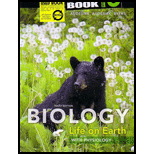
To determine:
The names of trophic levels in a community and also provide examples of organisms found in each trophic level.
Introduction:
Ecosystem is composed of all the biotic and abiotic components that exist together and interact with each other for their survival. Ecosystem consists of several trophic levels that mainly include the producers, consumers, detritivores, and decomposers. All the trophic levels in ecosystem are interconnected with each other.
To explain:
The flow of energy through an ecosystem.
Introduction:
The nutrient and energy flow helps in maintaining the balance of ecosystem. At first tropic level, the producers use solar energy for photosynthesis and produce organic material. At second tropic level the herbivores feed on producers, mainly plants. At third tropic level the carnivores or predators feed on the species of second tropic level. Decomposers break down the dead and decay matter and helps in returning essential nutrients back to soil which help the primary producers.
To explain:
The reason that detritivores and decomposers are essential to ecosystem function.
Introduction:
Ecosystem consists of various trophic levels which are interconnected to each other. Producers form the first trophic level and detritivores and decomposers form the final trophic level.
Detritivores and decomposers are the lower organisms that feed upon wastes, dead and decaying matter. Detritivores include organisms such as nematodes (worms), earthworms, millipedes, and larvae of some flies. Decomposers include
To explain:
The way in which inefficiency of energy transfer between trophic levels determines the relative abundances of organisms in the different trophic levels.
Introduction:
Sunlight is the important source of energy utilizes by all the life forms to carry out their functions. All living organism requires nutrients and energy for their survival. Energy and nutrients enter the ecosystem through photosynthesis by producers which results in the movement of energy in an ecosystem from one trophic level to another.
Trending nowThis is a popular solution!

Chapter 28 Solutions
Biology
 Human Anatomy & Physiology (11th Edition)BiologyISBN:9780134580999Author:Elaine N. Marieb, Katja N. HoehnPublisher:PEARSON
Human Anatomy & Physiology (11th Edition)BiologyISBN:9780134580999Author:Elaine N. Marieb, Katja N. HoehnPublisher:PEARSON Biology 2eBiologyISBN:9781947172517Author:Matthew Douglas, Jung Choi, Mary Ann ClarkPublisher:OpenStax
Biology 2eBiologyISBN:9781947172517Author:Matthew Douglas, Jung Choi, Mary Ann ClarkPublisher:OpenStax Anatomy & PhysiologyBiologyISBN:9781259398629Author:McKinley, Michael P., O'loughlin, Valerie Dean, Bidle, Theresa StouterPublisher:Mcgraw Hill Education,
Anatomy & PhysiologyBiologyISBN:9781259398629Author:McKinley, Michael P., O'loughlin, Valerie Dean, Bidle, Theresa StouterPublisher:Mcgraw Hill Education, Molecular Biology of the Cell (Sixth Edition)BiologyISBN:9780815344322Author:Bruce Alberts, Alexander D. Johnson, Julian Lewis, David Morgan, Martin Raff, Keith Roberts, Peter WalterPublisher:W. W. Norton & Company
Molecular Biology of the Cell (Sixth Edition)BiologyISBN:9780815344322Author:Bruce Alberts, Alexander D. Johnson, Julian Lewis, David Morgan, Martin Raff, Keith Roberts, Peter WalterPublisher:W. W. Norton & Company Laboratory Manual For Human Anatomy & PhysiologyBiologyISBN:9781260159363Author:Martin, Terry R., Prentice-craver, CynthiaPublisher:McGraw-Hill Publishing Co.
Laboratory Manual For Human Anatomy & PhysiologyBiologyISBN:9781260159363Author:Martin, Terry R., Prentice-craver, CynthiaPublisher:McGraw-Hill Publishing Co. Inquiry Into Life (16th Edition)BiologyISBN:9781260231700Author:Sylvia S. Mader, Michael WindelspechtPublisher:McGraw Hill Education
Inquiry Into Life (16th Edition)BiologyISBN:9781260231700Author:Sylvia S. Mader, Michael WindelspechtPublisher:McGraw Hill Education





